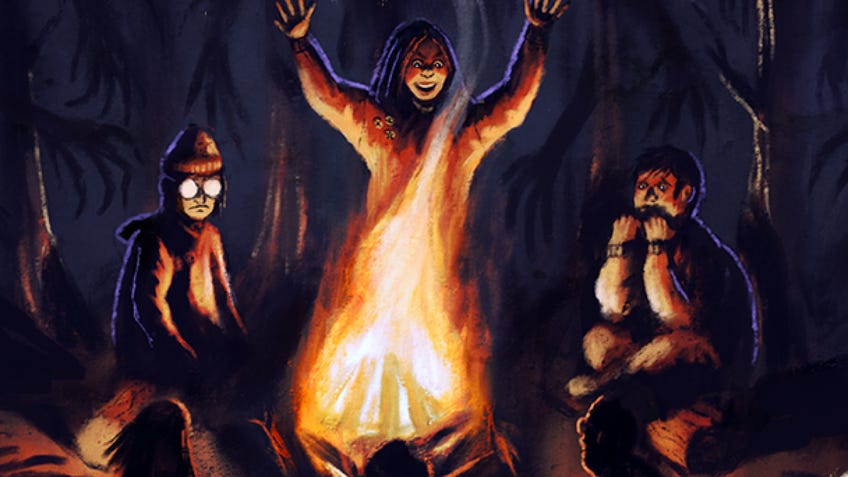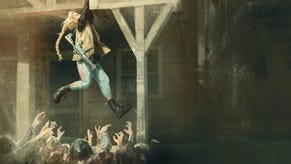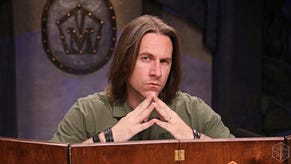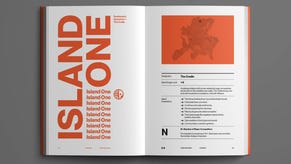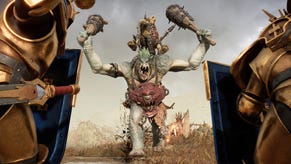The creators of horror anthology RPG Campfire talk killing characters and creating a truly scary experience
Cryptkeeper, eat your heart out.
Sharing scary tales around burning logs, our backs to the oppressively dark wilderness, is a time-honoured tradition, and designers Will Jobst and Adam Vass have conspired to transform it into a horror-inducing tabletop RPG.
Their new game, Campfire, lets two to six people collaboratively spin their own spine-tingling yarn using a deck of evocative cards, some coins and a metaphorical fire that waxes and wanes throughout the session. Ahead of their Kickstarter campaign’s final day - June 25th - we sat down with them to discuss their inspirations, safety tools and how to convince a group to kill their own creations.
In broad strokes, what is Campfire?
Will Jobst: Campfire itself is a storytelling game for a group of two to six players for anywhere from one to three hours. Pick a story as a group and play it, switching between the roles of narrator and listeners. You're playing on a shared play mat, in which you have Embers that are the burning core of your story - your people, places and things. And a narrator deck which you are flipping through as oracles that have text on them and images to incorporate into your scene-setting game. So it's a GM-less horror game that's great for brand new people to roleplaying and veteran story gamers.
What does the game’s structure look like, briefly?
Jobst: The game’s design breaks down into three acts. We begin by selecting our Embers. Once we have gone through five cards as a group we begin the Blaze, which is when we pour some fuel on the fire and edit our Embers. After this, you draw two cards every time it's the narrator's turn. During the Inferno, the fire grows out of control and you predict some grim fates for your Embers by voting with these coins gained throughout the game. At the end of The Thing, will Kurt Russell explode in the frozen cave, or will he get out somehow?
 We play Low Stakes -The What We Do In The Shadows inspired RPG- Vampires, Werewolves & Ghosts Oh My!
We play Low Stakes -The What We Do In The Shadows inspired RPG- Vampires, Werewolves & Ghosts Oh My!
Adam Vass: The coin economy fuels the abilities that you have, and how the story works in a collaborative way. You can pay coins from your hand to contribute ideas or to take control of particular Embers during the story, and you can take them to shift focus. We can do camera auts, we can introduce irony and we can do time jumps. When you're not quite sure what you want to do and want everyone's feedback, you can pull everyone in and reward the player with your favorite answer with a coin.
Why are you both drawn to horror anthology games as something you want to bring to the tabletop?
Vass: A lot of the media that Will and I share affection for is episodic TV series - the Sopranos and Breaking Bad but specifically anthology horror stories. We want to be able to tell these longer stories in shorter increments, the more rich and deep stories but without needing to see every moment of them and without needing to act out in detail every waking second. A 90-minute session is my dream, but I don't want to leave that 90 minutes feeling unfulfilled. Horror movies aren't generally famous for being extremely long. They kind of get to the point and give you what they said they were going to give and that's great. I think our goal, too, is to make something that feels complete in a shorter time frame but also just gives you the exact experience you expect going in.
It's thrilling playing with a group because you are always surprised what other people come up with and how they incorporate your details.
Jobst: How do we get the core experience of a game as tight and as quick as possible, so players can choose to experience it again? You watch an hour of TV, and you're like, “I can watch two more”, but you wouldn't want to do the same with a three hour movie. With Campfire, we can be the viewers, the writers and the directors of this experience. We really playtested the hell out of this game to get this really tight format that still felt rewarding and different every to you play.
Similarly, Campfire comes in these three moments within the game where the group takes a step back, looks at the story, makes a decision and then goes forward twice as fast as before. How many times have you been in a session where you're just racking your brain for the next thing to say? We hope that by shifting focus in different ways you just get that magic trick every time where someone is offering something interesting that is internally propulsive to the game.
What are some genre touchstones? What kind of stories are you telling?
Vass: We are aware that there is this wide range of subgenres within horror, and we accommodate for that. There are eight decks that are coming in the game, and they each sort of approach a different style of horror - or I give players a nudge in a particular direction. We have ghost stories, we have slasher stories, we have psychological horror and body horror. There's all these specific types. A place where Campfire excels is its ability to be curated and focused by the players to get the experience that they particularly want. No one's going to be surprised when they explore the body horror deck - that’s what they signed up for.

What is really rewarding for us as designers is that we built a system that feels good enough for a folk horror, a slasher, a comedy horror and an urban legend to all feel similarly at home in this mechanical space that we created.
saLet’s talk more about those decks. What does that element of the game look like?
Jobst: Basically, a deck is a story spark that comes with some introductory text, some content warnings and touchstones. It also comes with these Embers, which are people, places and things that we draft into the story. There's going to be more Embers to choose from than you use as a group, and the story decks contain infinite stories so that you will never functionally tell the same story twice.
Vass: A deck is basically composed of text based prompts that come in randomized order, but the deck is basically composed of three smaller decks with a natural escalation over the course of the game. Each story deck has a unique kind of visual identity to it, whether it's the textures or color schemes. Some will have more explicit imagery and some will just be kind of evocative. For example, you see that the first card says “grit, grime and filth in abundant supply”, and it's green with notes of purple in this texture. You might interpret that as a slime or some kind of radioactive aspect.
Campfire is a horror game, so it's going to have challenging content. We want to make sure that when players sit down to play, everyone is having conversations they want.
How did you pick visual elements that were evocative without too much guidance?
Jobst: Adam and I love to consider how much information you need to make a great scene. Sometimes the text on the card is used in a literal narration of the story, which always feels like when Vin Diesel says the Fast and Furious or whatever inside the movie. Or you use some other part of that element and get that challenge accepted moment where you're like, “I can figure this out. Let's make this work.” We want to let our writers write the most particular weirdo stories possible. And we want the very particular weirdness to show the many-limbed extremities of this game and system to just show what it's capable of.
Vass: Rather than have it be a game that feels antagonistic towards its players, [Campfire] is a game that deliberately is antagonistic towards its characters. The players can bond and collaborate and team up and work together to make it a living hell for the characters in a way where everyone gets input. Everyone shares the excitement of getting to witness as the audience, in addition to being the directors and the actors.

Was it difficult to encourage players to put their characters through hell and maybe even kill them?
Vass: I think it's actually easier for everyone to die than it is for not. [Laugh]. We are here to have fun as players and relish in the demise of our Embers.You go into it with this pre-stated expectation of what this game does.
Jobst: The concept is that every element of this game is an orbit of doom. It might not get trapped in the gravitational pull of doom and collide with Doom Planet, but they are affected in some way. None of the characters are yours; they are shared. So, you have this collaborative ownership or shepherdship of these characters, places and things that you can really step on the gas in any direction.
What kind of safety tools does Campfire have?
Jobst: Campfire is a horror game, so it's going to have challenging content. We want to make sure that when players sit down to play, everyone is having conversations they want. We've got a couple things: each story spark that has content warnings, includes media touchstones - that's my recalibration tool - and includes ratings like PG-13, R, the hard R, etc. We include Lines and Veils, the X-Card and a lot of the really common safety tools.
We built a system that feels good enough for a folk horror, a slasher, a comedy horror and an urban legend to all feel similarly at home.
Would you be happy to see players take Campfire outside of the horror genre?
Jobst: Uh, hell, yes.
Vass: Mix and matching cards could very easily make some like truly Gonzo and different experiences even within the core set. But we do plan to have systems by which people can make their own decks and release their own content for the game.
Jobst: This game really is a horror flavoured, collaborative, high interplay story game. Anything where you want players chiming in on this state of engagement for a short amount of time could look like so much more.
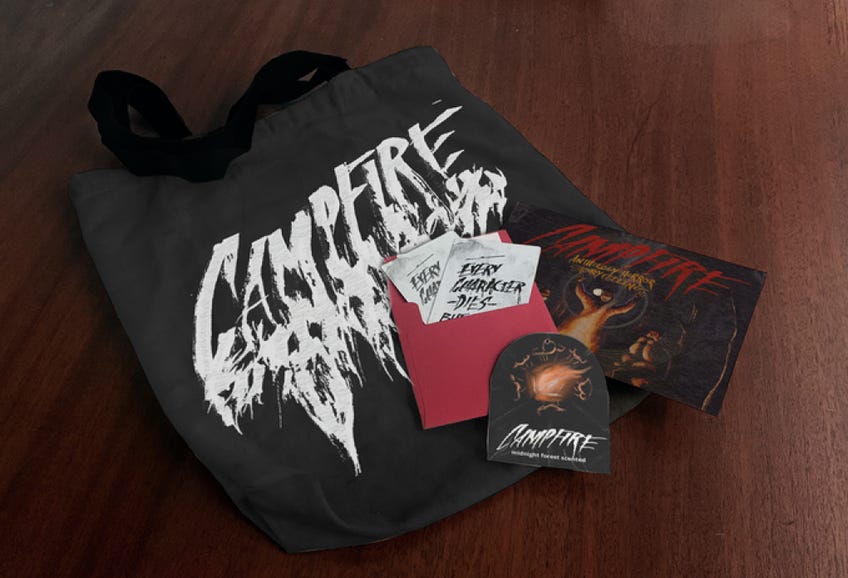
Does this game scare you? Will you have those same feelings that a horror movie gives you while playing Campfire?
Jobst: I come from the school of always announcing when I'm freaked out, which comes from the Chills rule of Bluebeard’s Bride. It's thrilling playing with a group because you are always surprised what other people come up with and how they incorporate your details. It feels like this very nice humanist collaboration that is fucking scary shit.
Vass: I think a lot of that fear comes from the unexpected and the unknown. Those moments are generated by your fellow players just as often as they are by the game. The idea that a player could just hold up a coin and say something you could have never foreseen? That is the excitement and the horror and the thrill of playing Campfire.
